See Charlotte’s Washington Heights neighborhood through the eyes of its greatest champion
- Oops!Something went wrong.Please try again later.
Mattie Marshall is sitting outside of Northwest School of the Arts, trying to explain what she thinks families who bring their kids from other parts of Charlotte think of the surrounding Washington Heights neighborhood.
At first, the 67-year-old longtime resident is doing so calmly.
“I think the people from outside, they see a lot of beauty,” she says, gesturing at the tall, lush tree canopy hanging over the school’s grounds in this mostly Black neighborhood — which was founded in 1913, named for Booker T. Washington and situated near where the Brookshire Freeway and Beatties Ford Road converge.
But before long, without provocation, Marshall starts to get worked up.
“Some people have a way of just picking out the negative,” she says, shaking her head. “I don’t understand that. ... I think it’s a lot of, maybe, misinformation. Or a lack of cultural understanding, or endurance of people (i.e. Black people).
“... They get into this ‘better-than’ mode. I guess it’s just like an abusive husband — you know, you keep hammering —” she smacks her fist into her palm three times as she talks “— that negative and a person gonna feel —” she smacks her fist two more times, a little harder and a little more slowly, “— that lack of self-worth. A hopelessness. You’ll feel that. That’s the only thing negative does.”
Marshall, a sharecropper’s daughter who grew up near Augusta, Georgia, takes a breath. “I just don’t have room,” Marshall says, finally, “for negativity.”
Since Washington Heights is a neighborhood and not a municipality, it doesn’t have a mayor. But if it did, Marshall would almost certainly be the best person for the job. She’s lived in the same house on Booker Avenue (also named for the legendary African American leader) since 1989, and been president of the Washington Heights Community Association for just as long.
It could be reasonably argued that there is not a single person alive who has done more than Marshall to lift up this particular neighborhood. To honor its historical significance as the first African-American streetcar suburb in Charlotte. To brighten its future by creating new senses of community pride.
And so there is no one better than Marshall to take us on a tour of Washington Heights that can highlight how she, with the help of many others, are trying to make those things happen.
Here are the most memorable moments from our tour.
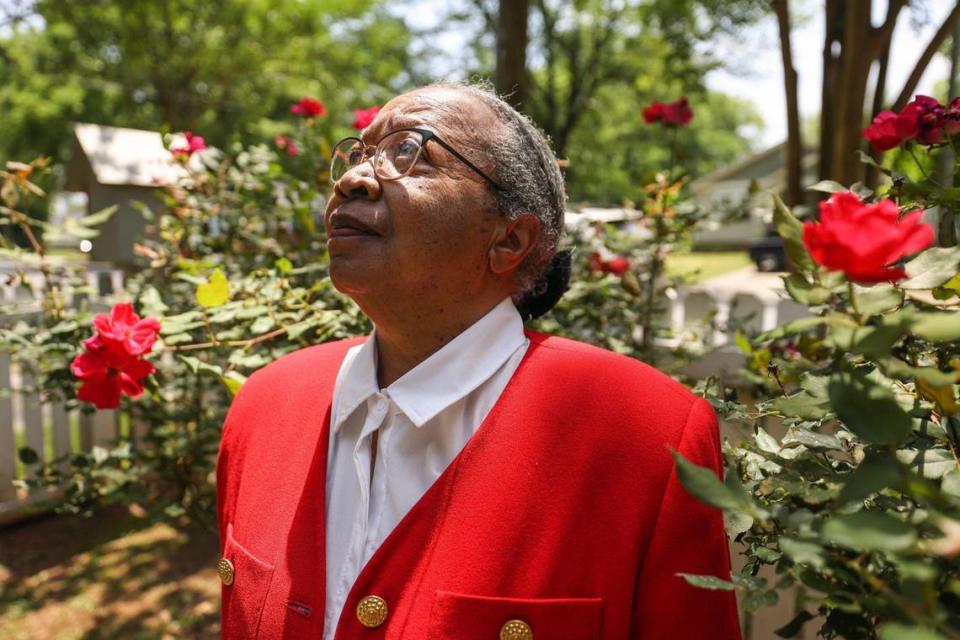
‘Sometimes it brings tears to your eyes’
The first place she guides us to is just three blocks from her driveway: The Historic Excelsior Club on Beatties Ford Road.
Founded in 1944 by the late Jimmie McKee, it is perhaps most famous for being included in “The Negro Motorist Green Book” as a nightclub welcoming to Blacks traveling through the South in the 1960s. It closed in 2016, it fell into disrepair, and was at one time slated for demolition. The building, from which you can take in a sweeping view of the Charlotte skyline, currently is surrounded by chain-link fence.
But if the new owner has his way, The Excelsior will reopen bigger and better. Developer Darius Anderson envisions a restaurant with live entertainment and dancing, a boutique hotel and a small museum — within the next few years.
Until then, it remains in limbo.
“It was a gathering place for the community,” Marshall says, “and the new owner, he wants to maintain that.”
At the same time, she hints that she’s worried the restoration plan won’t come to fruition. She mentions, for instance, the ongoing concerns about the area being able to provide adequate parking.
Then she gazes up at the club’s iconic logo and continues: “Sometimes it brings tears to your eyes. ... If you just tore it completely down, without any sensitivity to the history, it’s like it was never there, you know? ... As humanity, we can do a little bit more to continue God’s great creations.”
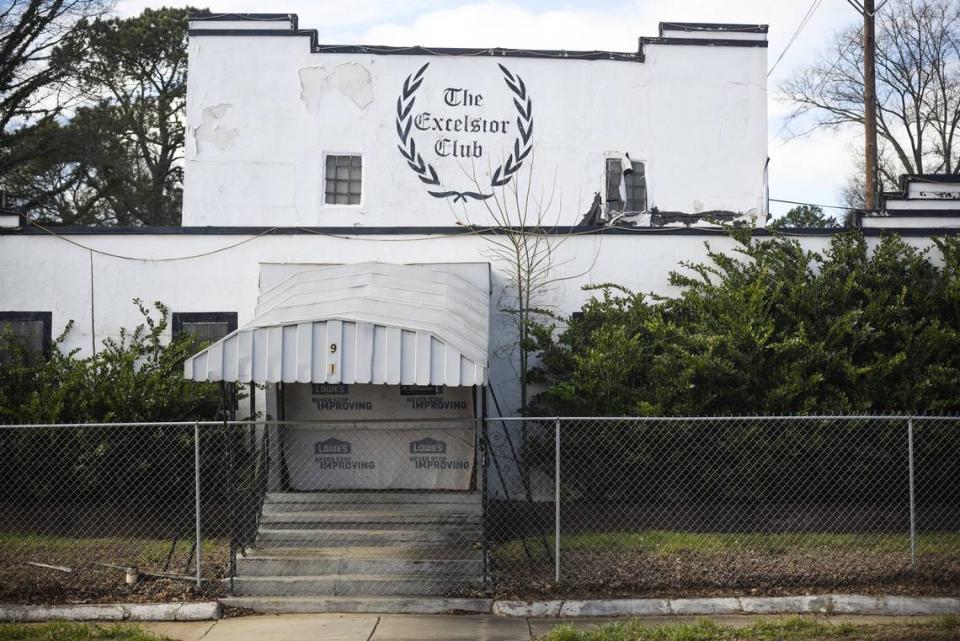
‘The highway just cut the neighborhoods off’
Before leaving The Excelsior, Marshall also looks slightly sorrowful as she nods to the on and off ramps for the Brookshire Freeway that start and end just 100 feet down Beatties Ford Road.
It’s been more than 50 years, long before she arrived in this area — but it’s something she still seems to take personally: the creation of the freeway eliminated one Washington Heights street — Douglas Street — and wiped out about 700 feet of another — Campus Street, which connected the neighborhood to Johnson C. Smith University.
Dozens of residents were displaced by the project.
Back in the car, after taking Sanders Avenue west away from The Excelsior, at the next stop sign she gestures left on Campus at the almost-immediate dead end. On the other side of the trees, cars accelerate onto Interstate 277.
“The highway just cut the neighborhoods off,” she says. Prior to its construction, “people would just walk over by Johnson C. Smith.” Marshall notes that Interstates 85 and 77 are not even a mile away, as well, and she quietly laments being “surrounded by all this environmental stuff. ... Pollution.”
But she wants to keep her tone positive, so she name-drops a famous neighbor: Dorothy Counts-Scoggins, one of the first Black students admitted to Charlotte’s Harding High (in 1957), lives on Campus Street — albeit on the other side of those highway ramps.
‘We all have a purpose on this earth’
We head up Redbud Street and turn left onto Pitts Drive, then pull into the entrance for Nia Point Apartments. Marshall has us park right in front of a community garden full of raised beds that haven’t been tended to in a while.
“We worked that with some of the students from Johnson C. Smith,” says Marshall, who serves the HBCU in a part-time role, as the coordinator of a STEM program for grad students. “And we have a neighbor that’s an artist, and he’s looking to help revitalize that (area) with art and so forth ... looking at getting different fruit trees or different flowers ... bringing it back to life.”
But that’s not why she wanted to show us this complex. She wanted to tell us about its name.
Nia Point is an 81-unit community overseen by affordable-housing provider Inlivian, which formerly was the Charlotte Housing Authority. The apartments were built in 2006, and Marshall says community leaders were given the opportunity to help name it.
They settled on Nia Point because, she says, “Nia is one of the Kwanzaa principles — and also Swahili for purpose.”
The “point”? Adds Marshall: “We all have a purpose on this earth.”
While exiting back out onto Pitts Drive, she notices a sign in front of a smaller, neighboring complex. “Lord, have mercy,” she says, sighing. “Done changed the name. ‘Oaklawn West.’ Mm, mm, mm. ... No purpose in that name.”
‘Eventually people will realize what’s up here’
Marshall guides us into a spot outside of Northwest School of the Arts, and lets forth a torrent of praise.
She says the school has always taken a welcoming stance toward those in the community who want to utilize its facilities for educational or enrichment opportunities and events, even if they have nothing to do with Northwest students. At one point, the school granted her use of indoor space for “an after-school tutorial slash leadership development program.”
She raves about the quality of the performances the school stages in its first-rate auditorium. (Alumni include Eva Noblezada, a two-time Tony Award nominee, and Ashlei Sharpe Chestnut, who recently had a recurring role on Paramount+’s “Star Trek: Picard” series.)
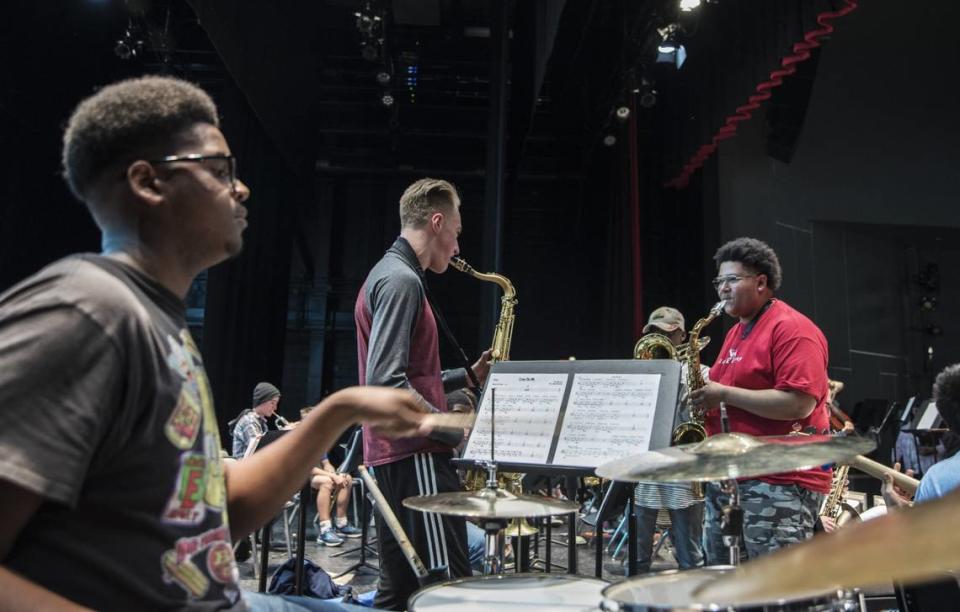
She loves the eye-popping colors on the mural Charlotte artist Rosalia Torres Weiner painted around the main entrance in 2019.
If there’s a missed opportunity related to Northwest, she says, it’s not so much on the school as it is on the community. Marshall is looking over at the field behind the school, where an impressive collection of fitness equipment is scattered. It’s part of a fitness trail that was put there for use by the general public in 2017; the school created it in partnership with the Jimmie Johnson Foundation, Lowe’s Toolbox for Education grant program and Greenfields Outdoor Fitness.
“I don’t think a lot of people are using it,” Marshall says. “I mean, it’s probably utilized a lot by the children. But eventually people will realize what’s up here. That they are welcome up here.”
‘Do you know what all these cars are doing here?’
We wind our way onto Remington Street, just northwest of Northwest, and pass two women walking in the direction we’re going — toward the main parking lot for L.C. Coleman Park. They’re the only white people we’ve seen so far on our tour of Washington Heights, so they stand out.
Upon pulling into the lot, we notice that there are more than a dozen cars parked ... but no actual people in sight. Not until the two women come back into view on foot.
As they pass, Marshall asks: “Are you all visiting? Do you know what all these cars are doing here?”
The women tell her they are returning from nearby Cedar Grove Cemetery, long ago a well-kept resting place for local African Americans that fell into disrepair after the caretaker himself died, in the 1970s. There have been recent efforts to clean up and clear out the overgrowth in the cemetery, including one on this day led by local nonprofit Veterans Bridge Home and attended by these two volunteers.
After they move on, Marshall explains how L.C. Coleman Park — named for the late Johnson C. Smith graduate and longtime neighborhood activist who fought to integrate county parks — is in the midst of its own revitalization.
Once a site that hosted festivals, summer camps and other community gatherings, it too had become a bit of an eyesore. Shortly before the pandemic, the park received a “D” rating from Mecklenburg County’s Park and Recreation Commission, along with several others in lower-income, historically under-served neighborhoods.
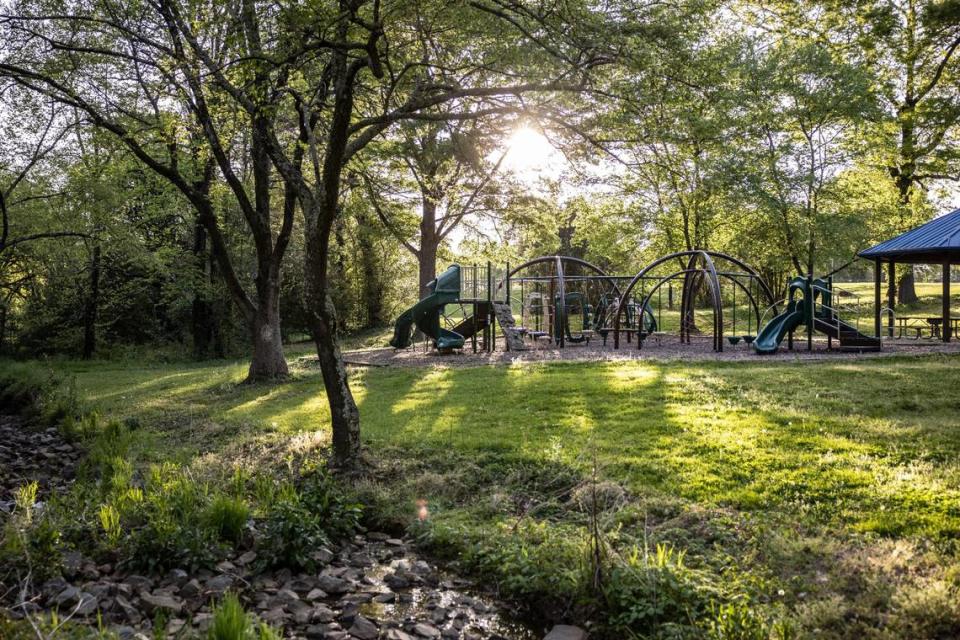
But it got a reprieve, in the form of a share (with two other struggling parks) of $2 million in equity funding. The announcement came in 2020, and that work should finally start soon. Then in 2022, Charlotte Hornets star LaMelo Ball teamed up with Puma to refurbish two basketball courts, right below the main parking lot, with purple and teal paint that still looks fresh.
Among the improvements on the way, she says, will be to make the park’s overgrown tennis court off Estelle Street also look new again. And this might be of interest, since those who’ve latched onto the craze are always looking for new places to play:
“I know,” Marshall says, “we are looking at pickleball.”
‘If you want to uplift yourself, uplift others’
One of our last stops is back closer to Marshall’s home — at The Ritz at Washington Heights, a colorful new pocket park/community gathering place on the site of the old segregation-era Ritz Theater, which went from bustling movie theater in the 1960s to vacant lot by the end of the ’70s.
There’s a funky-cool sign for The Ritz that was done by artist Junior Gomez, who lives across the street from Marshall; and Makayla Binter’s mural, splashed onto the shipping container that anchors the space, is a bold, striking visual tribute to Queen Charlotte.
Marshall, though, makes a beeline for the wall of quotes posted along the picket fence to the park’s rear. “We were intentional about putting up positive quotes,” she says, proudly. “Spreading that around.”
She reads a few of her favorites aloud:
“It isn’t where you came from, it’s where you’re going that counts.” — Ella Fitzgerald
“Education is the most powerful weapon that you can use to change the world.” — Nelson Mandela
“If you want to lift yourself up, lift up someone else.” — Booker T. Washington
A variation of that last quote is also featured in another much-larger mural just a block further south, on the side of a building that houses a recording studio, and a music management and promotion company. The building’s address is on Beatties Ford Road, but the mural’s accompanying visage of Washington Heights faces — appropriately — Booker Avenue. Marshall’s house is just six houses down.
“If you want to uplift yourself, uplift others,” artist Georgie Nakima (herself a Northwest graduate) painted in all-caps.
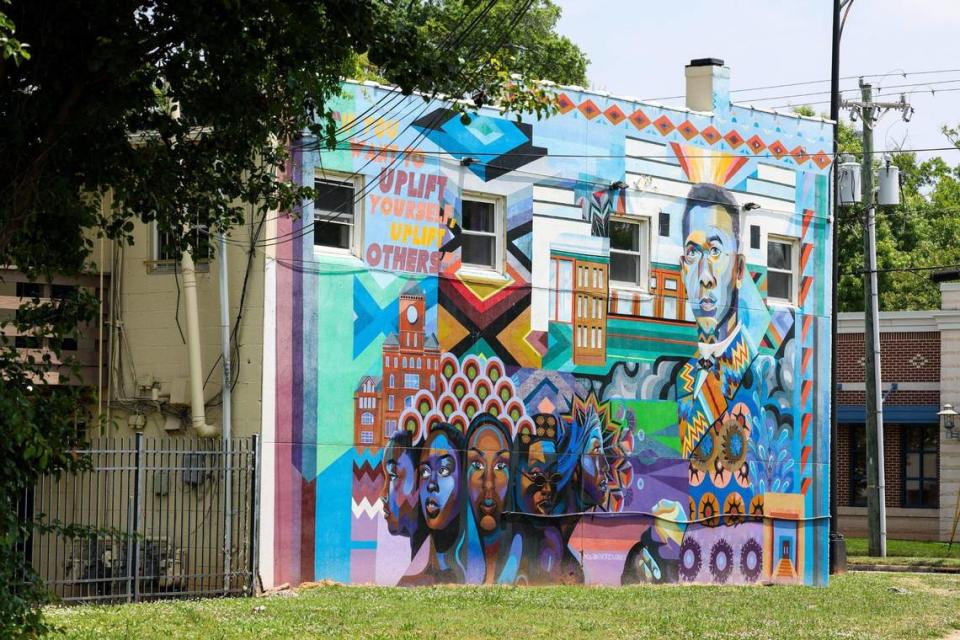
The mural aims to tell the story of Washington Heights in purples and oranges and reds and blacks, with nods to places we’ve just visited: Northwest School of the Arts. Johnson C. Smith University. The Excelsior Club.
We ask Marshall what she feels when she looks at this mural. She’s silent for several seconds before letting out a sigh and giving a short answer: “The greatness of my people. ... When I think of that —” she takes another long pause before continuing, by echoing Washington’s quote, “— it’s uplifting.”
Marshall concedes that moving Washington Heights toward a brighter future, while also properly honoring its past, has taken, is taking, and will continue to take “a long, long time.” She knows people who want positive change for the neighborhood are anxious for it. She is, too.
But with those things in mind, she points to one more quote that hangs on the fence back over at The Ritz park.
It’s from Harriet Tubman, and it says: “Every great dream begins with a dreamer. You have the strength, the patience, and the passion to reach for the stars to change the world.”
She puts equally forceful emphasis on all three of those words.

